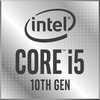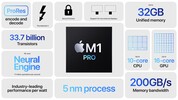Intel Core i5-10200H vs Apple M1 Pro
Intel Core i5-10200H
► remove from comparison
The Intel Core i5-10200H is a fast quad-core processor for laptops with four cores based on the Comet Lake-H series (4th generation of Skylake architecture). The processor clocks at between 2.4 and 4.1 GHz and can execute up to eight threads simultaneously thanks to Hyper-Threading. According to Intel, the CPU is manufactured on 14nm (14nm++) process.
The Comet Lake architecture is similar to Coffee Lake and offers the same features and is produced in the same 14nm process. Other than the improved clock rates, the memory controller now also supports faster DDR4-2933 RAM. More information on Comet Lake and all the models and articles on it can be found here.
The Core i5-10200H supports no vPro, TXT or SIPP. These business features are available in the faster (and later released) Core i5-10400H (2.6 - 4.6 GHz).
Performance
The performance is only minimal better than the Core i5-9300H thanks to the support for faster DDR4-2933 RAM. This means, the CPU is well suited for demanding tasks, although the faster versions offer a significantly higher Turbo Boost clock speed for faster single core execution.
Power consumption
This 10th gen Comet Lake processor has a default TDP (also known as the long-term power limit) of 45 W, a value that laptop manufacturers are allowed to reduce somewhat, 35 W being the lower limit. Doing so will result in lower clock speeds and lower performance. Either way, this CPU is too power-hungry to be used as the base of a passively cooled laptop.
Intel Core i5-10200H is built with an old, as of late 2022, 14 nm Intel process for subpar energy efficiency.
Apple M1 Pro
► remove from comparison
The Apple M1 Pro is a System on a Chip (SoC) from Apple that is found in the late 2021 MacBook Pro 14 and 16-inch models. It offers all 10 cores available in the chip divided in eight performance cores (P-cores with 600 - 3220 MHz) and two power-efficiency cores (E-cores with 600 - 2064 MHz). There is no Turbo Boost for single cores or short burst periods. The cores are similar to the cores in the Apple M1. The entry level model offers only 8 cores.
The big cores (codename Firestorm) offer 192 KB instruction cache, 128 KB data cache, and 24 MB shared L2 cache (up from 12 MB in the M1). The four efficiency cores (codename Icestorm) are a lot smaller and offer only 128 KB instruction cache, 64 KB data cache, and 4 MB shared cache. CPU and GPU can both use the 24 MB SLC (System Level Cache). The efficiency cores (E cluster) clock with 600 - 2064 MHz, the performance cores (P cluster) with 600 - 3228 MHz.
The unified memory (16 or 32 GB LPDDR5-6400) next to the chip is connected by a 256 bit memory controller (200 GB/s bandwidth) and can be used by the GPU and CPU.
The integrated graphics card in the M1 Pro offers all 16 cores.
Furthermore, the SoC integrates a fast 16 core neural engine, a secure enclave (e.g., for encryption), a unified memory architecture, Thunderbolt 4 controller, an ISP, and media de- and encoders (including ProRes).
The M1 Pro is manufactured in 5 nm at TSMC and integrates 33.7 billion transistors. The peak power consumption of the chip was advertised around 30W for CPU intensive tasks. In the Prime95 benchmark the chip uses in our tests (with a MBP16) 33.6W package power and 31W for the CPU part. In idle the SoC only reports 1W package power.
| Model | Intel Core i5-10200H | Apple M1 Pro | ||||||||||||||||||||||||||||||||||||||||||||||||||||||||||||||||||||
| Series | Intel Comet Lake | Apple Apple M-Series | ||||||||||||||||||||||||||||||||||||||||||||||||||||||||||||||||||||
| Codename | Comet Lake-H | |||||||||||||||||||||||||||||||||||||||||||||||||||||||||||||||||||||
| Series: Apple M-Series |
|
| ||||||||||||||||||||||||||||||||||||||||||||||||||||||||||||||||||||
| Clock | 2400 - 4100 MHz | 2064 - 3220 MHz | ||||||||||||||||||||||||||||||||||||||||||||||||||||||||||||||||||||
| L1 Cache | 256 KB | 2.9 MB | ||||||||||||||||||||||||||||||||||||||||||||||||||||||||||||||||||||
| L2 Cache | 1 MB | 28 MB | ||||||||||||||||||||||||||||||||||||||||||||||||||||||||||||||||||||
| L3 Cache | 8 MB | 24 MB | ||||||||||||||||||||||||||||||||||||||||||||||||||||||||||||||||||||
| Cores / Threads | 4 / 8 | 10 / 10 | ||||||||||||||||||||||||||||||||||||||||||||||||||||||||||||||||||||
| TDP | 45 Watt | |||||||||||||||||||||||||||||||||||||||||||||||||||||||||||||||||||||
| Technology | 14 nm | 5 nm | ||||||||||||||||||||||||||||||||||||||||||||||||||||||||||||||||||||
| max. Temp. | 100 °C | |||||||||||||||||||||||||||||||||||||||||||||||||||||||||||||||||||||
| Socket | BGA1440 | |||||||||||||||||||||||||||||||||||||||||||||||||||||||||||||||||||||
| Features | DDR4-2933 RAM, PCIe 3, 8 GT/s bus, MMX, BMI2, AES-NI, SSE4.1, ABM, VMX, EIST, RDRAND, SSE4.2, TM1, RDSEED, SSE, AVX, FMA, SMEP, TM2, SSE2, AVX2, ADX, SMAP, HT, SGX, SSE3, Turbo, SSSE3, MPX, SST | ARMv8 Instruction Set | ||||||||||||||||||||||||||||||||||||||||||||||||||||||||||||||||||||
| iGPU | Intel UHD Graphics 610 (350 - 1050 MHz) | Apple M1 Pro 16-Core GPU | ||||||||||||||||||||||||||||||||||||||||||||||||||||||||||||||||||||
| Architecture | x86 | ARM | ||||||||||||||||||||||||||||||||||||||||||||||||||||||||||||||||||||
| Announced | ||||||||||||||||||||||||||||||||||||||||||||||||||||||||||||||||||||||
| Manufacturer | ark.intel.com | |||||||||||||||||||||||||||||||||||||||||||||||||||||||||||||||||||||
| Transistors | 33700 Million |


 Deutsch
Deutsch English
English Español
Español Français
Français Italiano
Italiano Nederlands
Nederlands Polski
Polski Português
Português Русский
Русский Türkçe
Türkçe Svenska
Svenska Chinese
Chinese Magyar
Magyar
